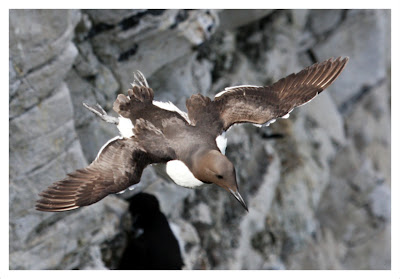The European Stonechat (Saxicola rubicola) is a small passerine 11.5–13 cm long and genetic evidence has placed it and its relatives in the Old World flycatcher family Muscicapidae.
The summer male has black upperparts, a black head, an orange throat and breast, and a white belly and vent. It also has white half-collar on the sides of its neck, a small white scapular patch on the wings, and a very small white patch on the rump often streaked with black. The female has brown upperparts and head, and no white neck patches, rump or belly, these areas being streaked dark brown on paler brown, the only white being the scapular patch on the wings and even this often being buffy-white. Birds are frequently seen flicking their wings while perched, often doing so on the tops of low bushes. As its name suggests, birds utter a sharp loud call that sound like two stones being tapped together.
They breed on heath, moors, grassland, and wasteland that have some dense shrubs, such as gorse, in which it can build a nest.
Stonechats are primarily insectivorous, feeding on caterpillars, moths, ants, spiders and flies, though they will also take worms and snails, and feed on seeds and berries in the autumn and winter.
The summer male has black upperparts, a black head, an orange throat and breast, and a white belly and vent. It also has white half-collar on the sides of its neck, a small white scapular patch on the wings, and a very small white patch on the rump often streaked with black. The female has brown upperparts and head, and no white neck patches, rump or belly, these areas being streaked dark brown on paler brown, the only white being the scapular patch on the wings and even this often being buffy-white. Birds are frequently seen flicking their wings while perched, often doing so on the tops of low bushes. As its name suggests, birds utter a sharp loud call that sound like two stones being tapped together.
They breed on heath, moors, grassland, and wasteland that have some dense shrubs, such as gorse, in which it can build a nest.
Stonechats are primarily insectivorous, feeding on caterpillars, moths, ants, spiders and flies, though they will also take worms and snails, and feed on seeds and berries in the autumn and winter.
Please click on the images to reveal the finer detail within the pixels
The following image is of the male that holds territory close to a busy road high up on the peak district upper moorlands.
2012 Male casting a cursory glance
2010 male in the same area but on the otherside of the road - is it me or do wire fences make great perches for images!
2011 male holding territory on Anglesey (N Wales)
the backdrop is a farm gate (the rusty bolt adds to the image)
The following image is of the female that holds territory close to a busy road high up on the peak district upper moorlands.
2012 Female
with a fine meal
perfect habitat shot
I have to drive 30 minutes or so to see this species as I dont have enough of the right habitat locally but its always worth for a fine species such as this












































